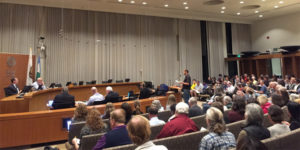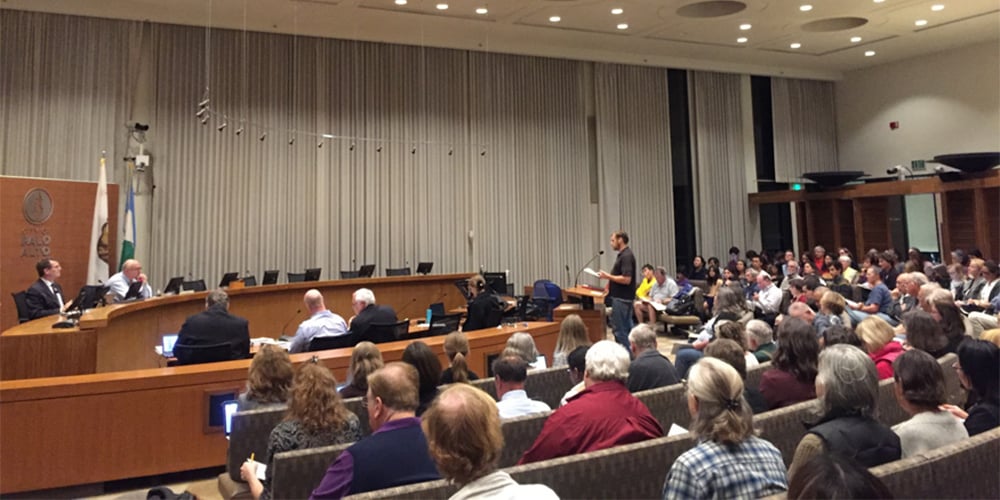Affordable housing and increased traffic were among the chief concerns brought up by members of the local community at Thursday night’s Community Feedback meeting held at the Palo Alto City Council.

Led by Santa Clara Director of Planning and Development Kirk Girard and Supervisor Joe Simitian, the meeting aimed to assess the Draft Environmental Impact Report (DEIR). The DEIR details potential environmental damage that might result from Stanford’s plans for land use included in their application for a renewed General Use Permit (GUP).
The renewed GUP will authorize Stanford’s plans for the use of its land for the next 17 years, including construction of an additional 3,150 net on-campus housing units and up to 2.275 million square feet of academic and support space — a 1.2 percent increase in space per year over the 17-year period — to facilitate further growth and innovation in education and research. If approved, the project will increase the availability and affordability of housing close to campus for faculty, staff and students and facilitate further growth and innovation in education and research.
The DEIR stated that the proposed GUP could have “significant and unavoidable” effects in three areas — construction noise, historic buildings and transportation — which can be mitigated with a series of measures the report stipulated. Of these concerns, traffic and housing figured most prominently among community members at Thursday’s meeting.
Traffic
According to the report, area freeways and intersections would see increased traffic, pending further studies on traffic counts to determine the impact on commuters. Recommended mitigation measures in the report include a program of “zero net new trips,” a goal that Stanford is already working toward with its transportation demand management scheme.
One Palo Alto local suggested that Stanford should not allow any of its students to drive cars in order to truly reduce traffic.
“[The GUP] is just concerned with what can we do for Stanford University and not what can we do for Santa Clara,” she said.
In an interview with Stanford News, Associate Vice President for Land Use and Environmental Planning Catherine Palter acknowledged the concern over potential increases in traffic congestion on campus, but said she was optimistic overall about Stanford’s environmental impact.
“We are fully committed to expanding our transportation programs that are designed to continue meeting the standard of no net new commute trips,” Palter said. “And because people at Stanford travel by car far less than others in the region, we believe Stanford is a very good place in the region for well-managed development.”
Housing and land use
A number of other speakers were concerned with the extent of the growth.
Simitian responded to concerns about carrying capacity of the University by reiterating that Stanford was required to complete a Sustainable Development Study when it applied for an updated GUP in 2000, which stated it “shall identify the maximum plan buildout potential for all of Stanford’s unincorporated Santa Clara county land.”
Other attendees worried that the expanded housing proposed under GUP would not prove sufficient for the needs of graduate students and staff members, who have tended to experience the effects of stiff housing prices in the area and long commutes particularly keenly.
“We really want affordable housing on campus because our workers are commuting from really far away,” said Francisco Preciado, executive director of SEIU Local 2007, an union that represents workers at Stanford and Santa Clara University. “If Stanford’s committed to the whole community, then by building more affordable housing for our service workers, they’re addressing the housing shortage and they’re also addressing the traffic impact litigation.”
Not all of the responses were negative, however. One Palo Alto local pointed out that Stanford is lucky to have the issue of using up potential housing space rather than encroaching on existing housing.
“If we were in any other part of the country talking about other university, we would be talking about them gobbling up existing housing,” he said.
Palter agreed that the University would incorporate considerations about land use in the surrounding area into its development plans.
“Stanford has a unique opportunity to address those impacts in a comprehensive and very successful way and we have a track record of doing it since 2000,” Palter said.
Nonetheless, community members continued to express concerns about the less measurable environmental effects of a Stanford construction project that might not be captured in a report.
“If you’re hearing dismay or disbelief of the citizens of Palo Alto it’s because we’ve been through this before,” one Palo Alto local said, raising worries about traffic congestion and Stanford’s groundwater use.
The next Community Feedback meeting will be held on Nov. 30 at the Palo Alto Arts Center, and will be accepting written concerns until Dec. 4.
Contact Julia Ingram at jmingram ‘at’ stanford.edu
